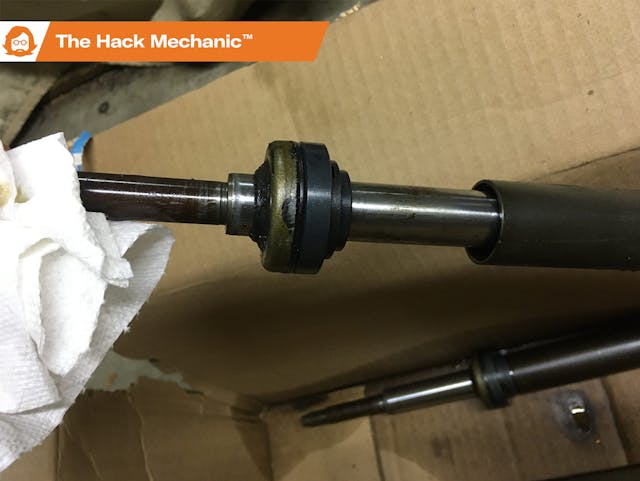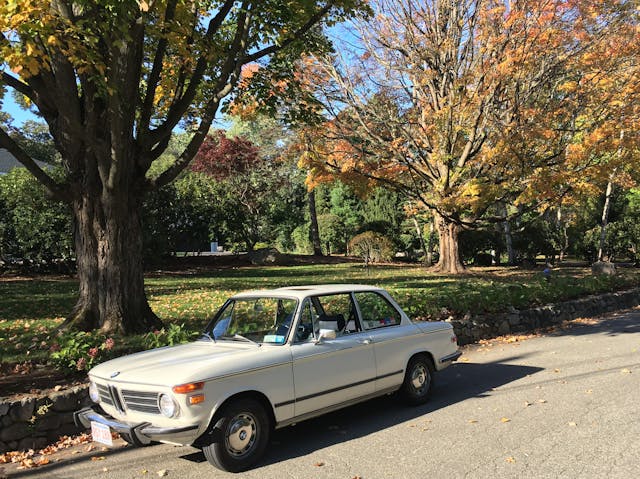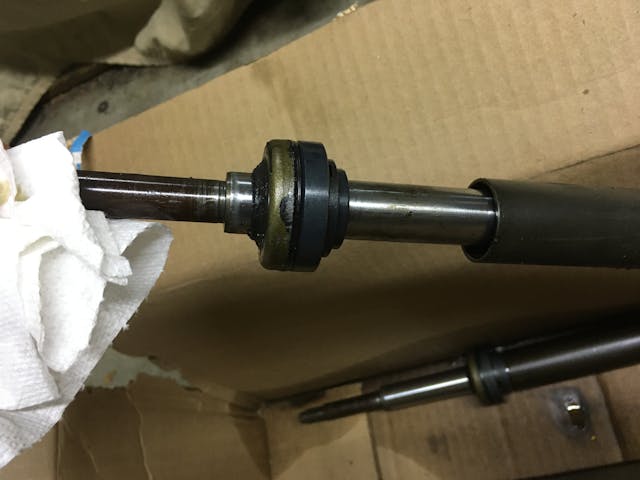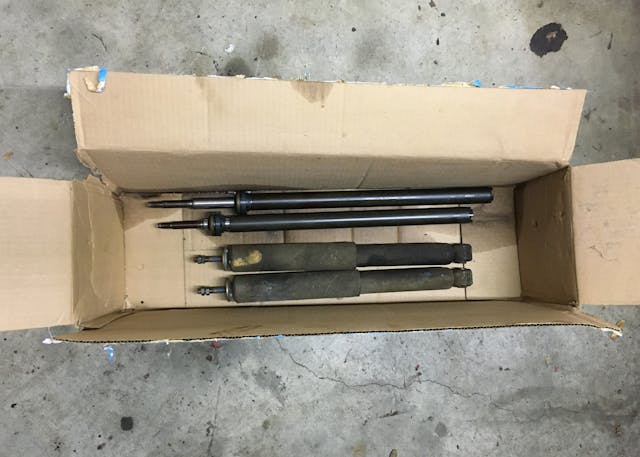Media | Articles
The Suspension of Disbelief: The “Wet Strut”

I say this over and over: I’m an enthusiast, not a collector. I buy what I like and what I can afford, not what I think will appreciate in value. And I’m certainly not seeking out the best cars in the best possible condition. Instead, I’m a bottom-feeder. I generally buy needy cars, usually laden with patina, which I happen to like.
And then, along came Hampton, the startingly original, very pretty, and nearly rust-free 49,000-mile 1973 BMW that I bought from its original owner a little over two years ago. It had been sitting in a barn (a garage, really) in Bridgehampton, Long Island, for about a decade. It needed the usual retinue of fresh fuel and new clutch hydraulics to run and drive, but as sort-outs go, it was relatively straightforward. It was enough to make me think, “Oh, so this is what collectors do” and start seeing dollar signs.
While I am a firm believer that while we own cars, we are free to do whatever we want to them (as opposed to thinking that the cars are owned “by the ages” and are only passing through our hands), from a market standpoint it made sense for me to be hyper-aware that anything that disturbed Hampton’s originality and its survivor pedigree could negatively affect the car’s value. So, I left it as intact as I could, including the fact that it was still wearing the original exhaust gas recirculation (EGR) plumbing and the original shocks and struts, as these were badges of honor, physical manifestations that supported the low-mileage single-owner intact survivor story. And I was very careful with repairs, going as far as getting the original water pump rebuilt so it would retain the correct date code and buying a 45-year-old plastic clutch hydraulic line, as it was the correct color plastic.
The fact that it was wearing skinny 165 series tires was a little more complicated. They weren’t the original Michelin XAS rubber. Instead, they were 20-year-old off-brand shoes (Calientes—now there’s a brand with loyalty and staying power), likely mounted before Hampton became a beach car and then was stored away. They looked nearly new and had absolutely no dry rot or cracks but had flat spots from their long sit that did not round out with driving. If I planned to road-trip the car any serious distance, I would’ve instantly replaced them, but for sort-out driving, or even shuttling it the 50 miles to one of my rented garages in Fitchburg, Massachusetts, I had no qualms about driving on them, and it made sense to leave the choice of real rubber to the next owner.
As I wrote earlier this year, I put Hampton on Bring a Trailer and expected it to sell, but I was stunned when the bidding stalled and the car didn’t reach a reasonable reserve. A bit shellshocked and not really sure what to do, I simply put the car away in Fitchburg and left it there. Part of this was calculated—I don’t have enough storage space; I was counting on not only the money from the sale but also freeing up a garage bay; and people were making me offers on Hampton and I didn’t want to do anything rash—but mostly I just needed a break from the car.
Marketplace
Buy and sell classics with confidence
So, it sat.
As fall settled in on New England, the pace of my automotive endeavors shifted. I drove my BMW 635CSi 2000 miles to The Vintage event in Asheville, North Carolina, took a 400-mile road trip in my beloved 3.0CSi to the nearby Vintage at Saratoga, and then ran down to Nantucket (well, as far as the ferry in Hyannis) in my 2002tii. It was great fun and reminded me that owning these cars is supposed to be fun.
Then, as the temperature dropped, it naturally de-emphasized the need for air-conditioning (which most of my cars have have) and pushed my cars that don’t have A/C to the front burner. This includes the Lotus Europa, my little BMW Z3 roadster (which has A/C, but I never got the belt back on after replacing the compressor bracket), and … Hampton.
So, in an egalitarian everyone-gets-his-turn spirit, one day a few weeks ago I found myself driving out to Fitchburg in the ’72 2002tii, swapping it for Hampton, and motoring the hour back home. During the delightful fall drive, I had two completely contradictory reactions to the tidy original little 2002.
Reaction #1: Compared to both my 2002tii and my ’75 2002—a former track rat, nicknamed Bertha, with the molar-rattling suspension, dual Weber 40DCOEs, and hot cam—Hampton is laughably slow. And the suspension (remember, original shocks and struts) is so soft that it nearly induces sea sickness.
Reaction #2: You know, this is actually kind of nice. It’s certainly in way better condition than the other two 2002s. If the tires (whose date codes intersected with the Clinton administration) weren’t clearly flat-spotted from their 10-year sit, and if the shocks and struts didn’t have the consistency of oatmeal, it might be almost pleasant.

So, what do you do? Do you hang onto the highly questionable idea that any mileage you put on the car and any original components you remove from it move it further away from its “fresh from the barn” unmolested vibe, or do you make the car more enjoyable and safer to drive, and then drive it?
As the adorable Penelope Cruz said at the end of the very strange movie Vanilla Sky, “It’s a problem.”
First, let me just say what many of you are thinking. This is a 49,000-mile BMW 2002, not a 5000-mile Ferrari Lusso. In the pantheon of cars and values, it’s small potatoes. And “unmolested survivor condition” is not concours condition. The real increase in value would come from excising the tiny amount of rust and returning the car’s engine compartment and undercarriage to near-showroom status. That’s what those bidding on BaT want to see. So, what you think you’re doing by being miserly about clicking up the car’s odometer and obsessing over correct hose clamps in the engine compartment have far less effect on the car’s value than you think.
Yeah, well, you’re right. Sometimes I just need to slap myself and say, “You’re an idiot.”
But in my defense, when they were new, 2002s weren’t Lotus Europas. They were bought as primary vehicles, not second or third cars, and people drove the pants off them. So 49,000-mile 2002s are quite rate. In contrast, when I bought my Lotus, I thought that, with 24,000 miles on the clock, I’d have one of the lowest-mileage Europas around. I then learned that many of them have that kind of mileage because something big and bad broke (usually the water pump, a replacement that generally requires engine removal), so the car was rolled into a barn and left there for decades. But I digress.
I started with the skinny old tires. Those 165/80/13s are archaic enough that The Tire Rack doesn’t even sell anything in that size. However, the slightly wider 185/70/13 was a common step up back in the day, they’re still widely available, and they’re cheap enough to be almost disposable if I sell the car and the new owner wants something else. In the meantime, I have something without flat spots. On they went.
Next, the shocks and struts. The go-to move on most vintage BMWs is to install Bilstein Heavy Dutys (HDs). Unfortunately, HDs for the 2002 have been on backorder for months. Bilsteins are generally long lived—and used sets do show up on eBay (I’ve had good luck buying used sets)—but they get snatched up quickly. I jumped on eBay, and to my delight, saw a set of front HD struts and rear HD shocks from two different sellers, both with very reasonable Buy it Now prices. I clicked and bought, and within a week I had parts in hand. I began tearing into the car.
Rear shocks are easy. You jack up the car, undo the nut at the bottom of the shock, pull it off its threaded stud, remove the lock nuts from the top, drop out the old shock, put in the new one, do the other side, done. When the HDs were installed, I liked the way that the old scuffed-up yellow Bilstein paint looked against the car’s undercarriage, like they’d always been there. Much more in keeping with the car’s vibe than a blazingly bright set of new yellow and blue Bilsteins.

Front MacPherson-style struts, however, are much more involved to replace, as the whole strut assembly has to be removed from the car, and a spring compressor has to be used to take the tension off the “hat” at the top of the strut assembly so it can be unbolted from the top of the strut cartridge without launching across the garage (or into your face). But I’ve done this many times, and as long as you don’t get sucked down the slippery slope of rebuilding the entire front end, it’s not that big of a deal. I yanked the left strut assembly out of the car, got the spring off it, used a pipe wrench to break the collar nut holding the strut cartridge in the tube free, and began pulling out the old strut cartridge. Oil poured out and onto my garage floor. I don’t mean dripped. I mean poured.
Wait, what?

It took a few seconds, but my brain caught up. These cars originally had oil-filled “wet struts,” so-called because they used an insert consisting of an open tube with a piston inside it, and the main strut housing held oil that was used to bathe the insert. (I’d like to say that the Brits called them “dampers,” which would be appropriate because they certainly were, um, damp, but unfortunately, “dampers” refers to any shock absorber. Damn. It was such a good pun.) This is an early design, distinct from later hydraulic shocks and struts that internally use fluid but are sealed. You almost never find wet struts on actual running, road-worthy, vintage BMWs.

Their novelty notwithstanding, I certainly had no qualms about replacing these ancient strut cartridges, parts that almost can’t be seen even from under the car, with modern units that work better and make the car ride and handle better. My reaction was to drain the oil out of the wet strut and toss it in the garbage along with the rear shocks I’d just replaced. And when I got to the right strut, I chucked that one into the trash barrel as well.
But then I reconsidered. I searched for “wet strut” and “oil-filled strut” on bmw2002faq.com, the 2002 brain trust. I found only a handful of posts, including one from a very meticulous guy I know who tried rebuilding a pair and determined that it was a terrible exercise in misplaced loyalty. The prevailing wisdom was to ditch them and replace them with a modern set of Bilstein HDs. Right. Done. Move on.
But still, something stayed my hand.
Now, I realize a 49,000-mile BMW 2002 is not a historically significant car. And this one, while a remarkably original survivor, is never going to be a concours entrant, at least not under my tutelage. But who knows what the next owner might want? While shocks and struts are normal-wear-and-tear parts, and while I can’t imagine that anyone would ever want to rebuild and reinstall these any more than they’d want the original brake pads, the wet struts are part of the story of the car’s originality. I may be moving Hampton further away from its one-owner-stored-for-years-and-fresh-out-of-the-barn roots and coaxing it in the direction of being a driver instead of a garage queen, but the physical evidence of “Crikey, it still was driving around with these wet struts in it” is something I can’t bring myself to toss.
So, I fished them out of the trash.
Of course, then I had to fish the rear shocks out of the trash as well. I mean, if you’re going to keep an obsolete suspension, you might as well have a full matched set.
So now I have to figure out where to keep a box with two barely functioning rear shocks and a pair of “wet struts” that, now that they’re no longer submerged in oil, will probably deteriorate instantly like an animated mummy exposed to air in an Indiana Jones movie.

But Hampton does ride much better with the Bilsteins in it.
***
Rob Siegel’s new book, The Best of the Hack MechanicTM: 35 years of hacks, kluges, and assorted automotive mayhem, is available on Amazon. His other seven books are available here, or you can order personally-inscribed copies through his website, www.robsiegel.com.







